Social Determinants and Healthcare: Case Study on Carla's Challenges
VerifiedAdded on 2022/07/29
|8
|2133
|29
Case Study
AI Summary
This case study examines the profound impact of social determinants on healthcare access and individual well-being, using the challenging circumstances of Carla and her family as a focal point. The assignment delves into the socio-demographic factors, including poverty, lack of education, and limited employment opportunities, that shape their lives and hinder their ability to meet basic needs and access healthcare. It analyzes how these factors contribute to health disparities and chronic diseases, such as gestational diabetes. Furthermore, the study explores the critical roles of healthcare professionals in addressing these issues, emphasizing strategies such as education, awareness programs, outreach services, and skill development initiatives. The study also looks at the importance of community-based interventions and policy changes to reduce poverty and improve the overall quality of life for vulnerable populations, highlighting the need for a collaborative approach to address the complex interplay between social determinants and health outcomes.
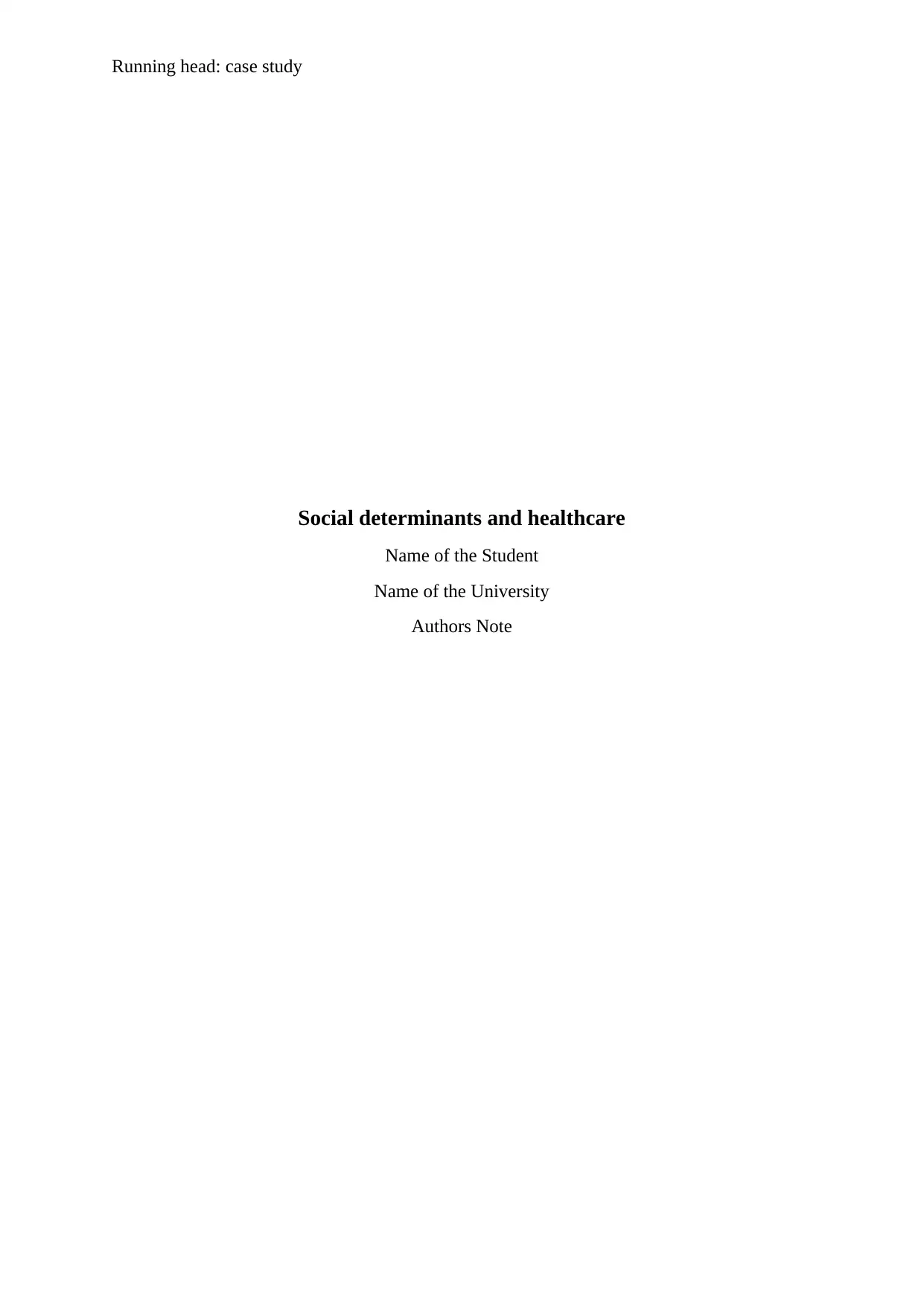
Running head: case study
Social determinants and healthcare
Name of the Student
Name of the University
Authors Note
Social determinants and healthcare
Name of the Student
Name of the University
Authors Note
Paraphrase This Document
Need a fresh take? Get an instant paraphrase of this document with our AI Paraphraser
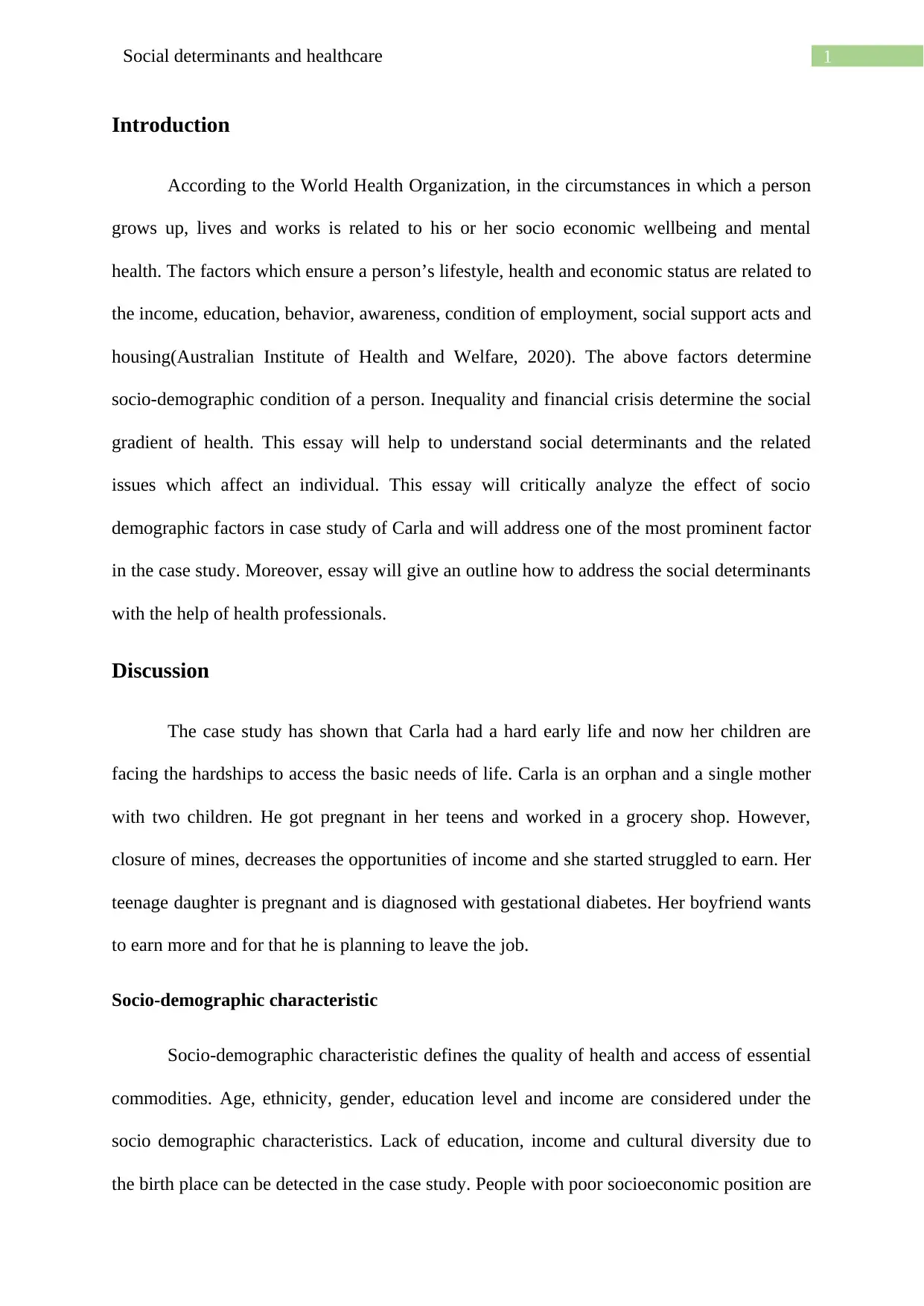
1Social determinants and healthcare
Introduction
According to the World Health Organization, in the circumstances in which a person
grows up, lives and works is related to his or her socio economic wellbeing and mental
health. The factors which ensure a person’s lifestyle, health and economic status are related to
the income, education, behavior, awareness, condition of employment, social support acts and
housing(Australian Institute of Health and Welfare, 2020). The above factors determine
socio-demographic condition of a person. Inequality and financial crisis determine the social
gradient of health. This essay will help to understand social determinants and the related
issues which affect an individual. This essay will critically analyze the effect of socio
demographic factors in case study of Carla and will address one of the most prominent factor
in the case study. Moreover, essay will give an outline how to address the social determinants
with the help of health professionals.
Discussion
The case study has shown that Carla had a hard early life and now her children are
facing the hardships to access the basic needs of life. Carla is an orphan and a single mother
with two children. He got pregnant in her teens and worked in a grocery shop. However,
closure of mines, decreases the opportunities of income and she started struggled to earn. Her
teenage daughter is pregnant and is diagnosed with gestational diabetes. Her boyfriend wants
to earn more and for that he is planning to leave the job.
Socio-demographic characteristic
Socio-demographic characteristic defines the quality of health and access of essential
commodities. Age, ethnicity, gender, education level and income are considered under the
socio demographic characteristics. Lack of education, income and cultural diversity due to
the birth place can be detected in the case study. People with poor socioeconomic position are
Introduction
According to the World Health Organization, in the circumstances in which a person
grows up, lives and works is related to his or her socio economic wellbeing and mental
health. The factors which ensure a person’s lifestyle, health and economic status are related to
the income, education, behavior, awareness, condition of employment, social support acts and
housing(Australian Institute of Health and Welfare, 2020). The above factors determine
socio-demographic condition of a person. Inequality and financial crisis determine the social
gradient of health. This essay will help to understand social determinants and the related
issues which affect an individual. This essay will critically analyze the effect of socio
demographic factors in case study of Carla and will address one of the most prominent factor
in the case study. Moreover, essay will give an outline how to address the social determinants
with the help of health professionals.
Discussion
The case study has shown that Carla had a hard early life and now her children are
facing the hardships to access the basic needs of life. Carla is an orphan and a single mother
with two children. He got pregnant in her teens and worked in a grocery shop. However,
closure of mines, decreases the opportunities of income and she started struggled to earn. Her
teenage daughter is pregnant and is diagnosed with gestational diabetes. Her boyfriend wants
to earn more and for that he is planning to leave the job.
Socio-demographic characteristic
Socio-demographic characteristic defines the quality of health and access of essential
commodities. Age, ethnicity, gender, education level and income are considered under the
socio demographic characteristics. Lack of education, income and cultural diversity due to
the birth place can be detected in the case study. People with poor socioeconomic position are
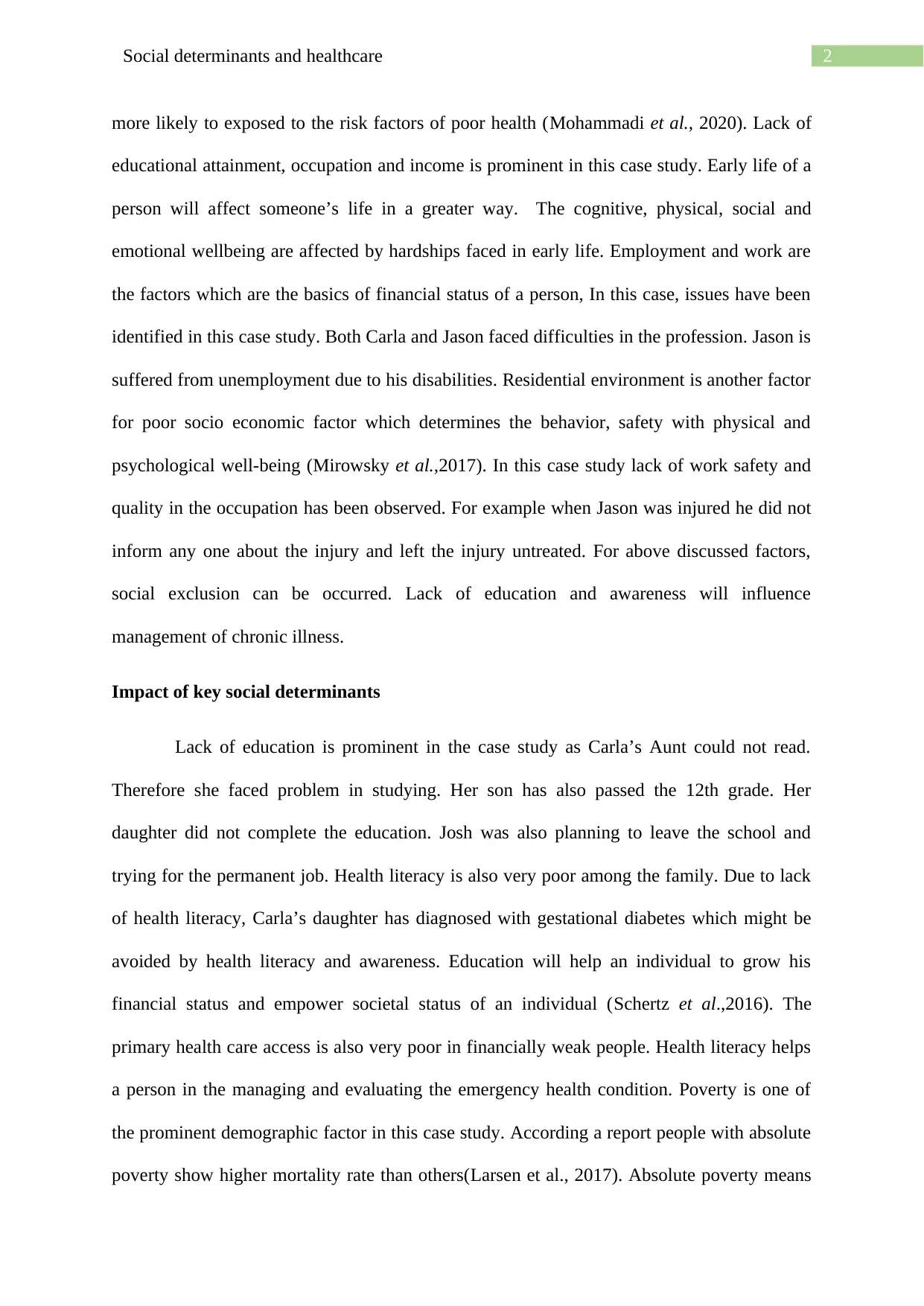
2Social determinants and healthcare
more likely to exposed to the risk factors of poor health (Mohammadi et al., 2020). Lack of
educational attainment, occupation and income is prominent in this case study. Early life of a
person will affect someone’s life in a greater way. The cognitive, physical, social and
emotional wellbeing are affected by hardships faced in early life. Employment and work are
the factors which are the basics of financial status of a person, In this case, issues have been
identified in this case study. Both Carla and Jason faced difficulties in the profession. Jason is
suffered from unemployment due to his disabilities. Residential environment is another factor
for poor socio economic factor which determines the behavior, safety with physical and
psychological well-being (Mirowsky et al.,2017). In this case study lack of work safety and
quality in the occupation has been observed. For example when Jason was injured he did not
inform any one about the injury and left the injury untreated. For above discussed factors,
social exclusion can be occurred. Lack of education and awareness will influence
management of chronic illness.
Impact of key social determinants
Lack of education is prominent in the case study as Carla’s Aunt could not read.
Therefore she faced problem in studying. Her son has also passed the 12th grade. Her
daughter did not complete the education. Josh was also planning to leave the school and
trying for the permanent job. Health literacy is also very poor among the family. Due to lack
of health literacy, Carla’s daughter has diagnosed with gestational diabetes which might be
avoided by health literacy and awareness. Education will help an individual to grow his
financial status and empower societal status of an individual (Schertz et al.,2016). The
primary health care access is also very poor in financially weak people. Health literacy helps
a person in the managing and evaluating the emergency health condition. Poverty is one of
the prominent demographic factor in this case study. According a report people with absolute
poverty show higher mortality rate than others(Larsen et al., 2017). Absolute poverty means
more likely to exposed to the risk factors of poor health (Mohammadi et al., 2020). Lack of
educational attainment, occupation and income is prominent in this case study. Early life of a
person will affect someone’s life in a greater way. The cognitive, physical, social and
emotional wellbeing are affected by hardships faced in early life. Employment and work are
the factors which are the basics of financial status of a person, In this case, issues have been
identified in this case study. Both Carla and Jason faced difficulties in the profession. Jason is
suffered from unemployment due to his disabilities. Residential environment is another factor
for poor socio economic factor which determines the behavior, safety with physical and
psychological well-being (Mirowsky et al.,2017). In this case study lack of work safety and
quality in the occupation has been observed. For example when Jason was injured he did not
inform any one about the injury and left the injury untreated. For above discussed factors,
social exclusion can be occurred. Lack of education and awareness will influence
management of chronic illness.
Impact of key social determinants
Lack of education is prominent in the case study as Carla’s Aunt could not read.
Therefore she faced problem in studying. Her son has also passed the 12th grade. Her
daughter did not complete the education. Josh was also planning to leave the school and
trying for the permanent job. Health literacy is also very poor among the family. Due to lack
of health literacy, Carla’s daughter has diagnosed with gestational diabetes which might be
avoided by health literacy and awareness. Education will help an individual to grow his
financial status and empower societal status of an individual (Schertz et al.,2016). The
primary health care access is also very poor in financially weak people. Health literacy helps
a person in the managing and evaluating the emergency health condition. Poverty is one of
the prominent demographic factor in this case study. According a report people with absolute
poverty show higher mortality rate than others(Larsen et al., 2017). Absolute poverty means
⊘ This is a preview!⊘
Do you want full access?
Subscribe today to unlock all pages.

Trusted by 1+ million students worldwide
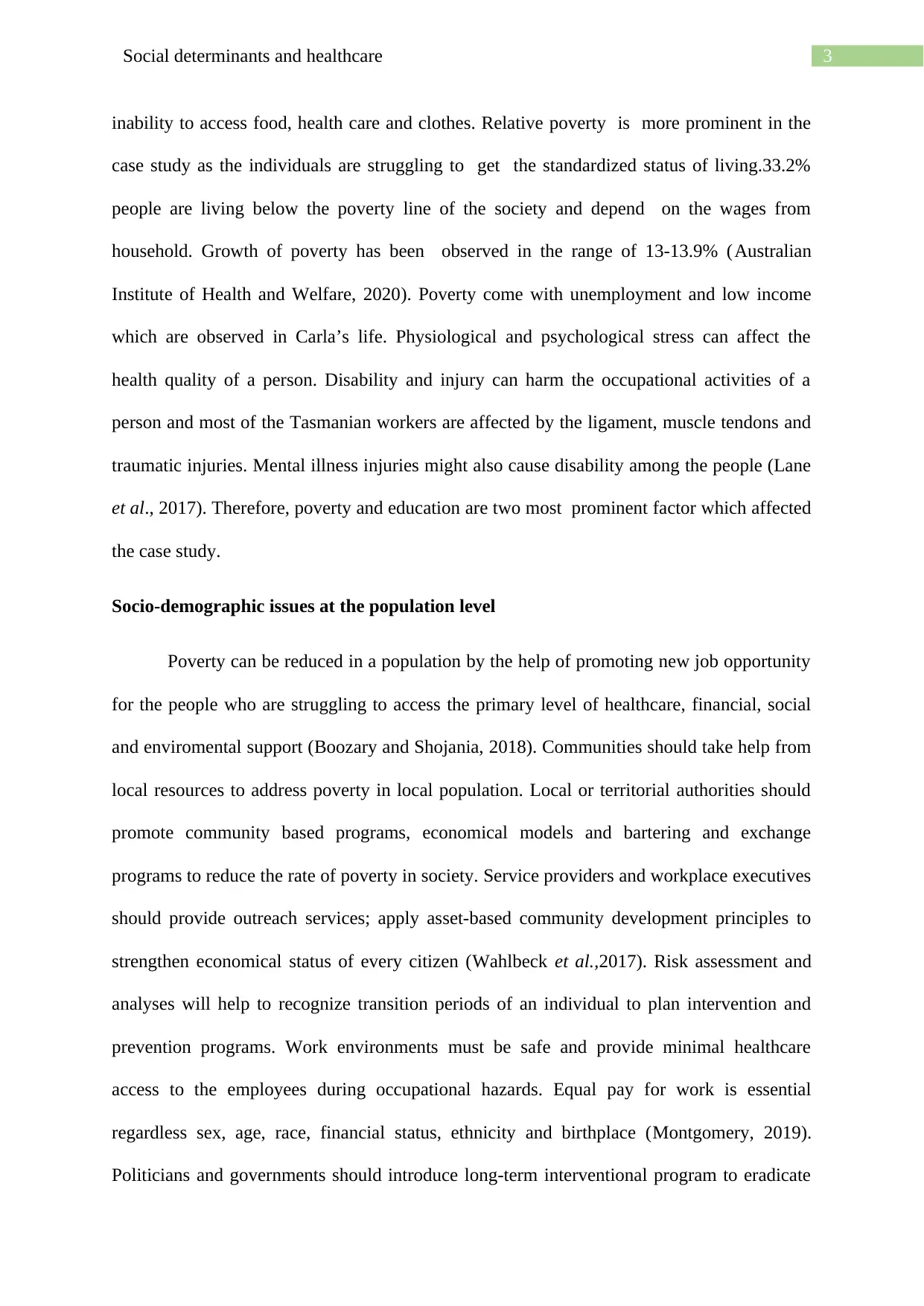
3Social determinants and healthcare
inability to access food, health care and clothes. Relative poverty is more prominent in the
case study as the individuals are struggling to get the standardized status of living.33.2%
people are living below the poverty line of the society and depend on the wages from
household. Growth of poverty has been observed in the range of 13-13.9% (Australian
Institute of Health and Welfare, 2020). Poverty come with unemployment and low income
which are observed in Carla’s life. Physiological and psychological stress can affect the
health quality of a person. Disability and injury can harm the occupational activities of a
person and most of the Tasmanian workers are affected by the ligament, muscle tendons and
traumatic injuries. Mental illness injuries might also cause disability among the people (Lane
et al., 2017). Therefore, poverty and education are two most prominent factor which affected
the case study.
Socio-demographic issues at the population level
Poverty can be reduced in a population by the help of promoting new job opportunity
for the people who are struggling to access the primary level of healthcare, financial, social
and enviromental support (Boozary and Shojania, 2018). Communities should take help from
local resources to address poverty in local population. Local or territorial authorities should
promote community based programs, economical models and bartering and exchange
programs to reduce the rate of poverty in society. Service providers and workplace executives
should provide outreach services; apply asset-based community development principles to
strengthen economical status of every citizen (Wahlbeck et al.,2017). Risk assessment and
analyses will help to recognize transition periods of an individual to plan intervention and
prevention programs. Work environments must be safe and provide minimal healthcare
access to the employees during occupational hazards. Equal pay for work is essential
regardless sex, age, race, financial status, ethnicity and birthplace (Montgomery, 2019).
Politicians and governments should introduce long-term interventional program to eradicate
inability to access food, health care and clothes. Relative poverty is more prominent in the
case study as the individuals are struggling to get the standardized status of living.33.2%
people are living below the poverty line of the society and depend on the wages from
household. Growth of poverty has been observed in the range of 13-13.9% (Australian
Institute of Health and Welfare, 2020). Poverty come with unemployment and low income
which are observed in Carla’s life. Physiological and psychological stress can affect the
health quality of a person. Disability and injury can harm the occupational activities of a
person and most of the Tasmanian workers are affected by the ligament, muscle tendons and
traumatic injuries. Mental illness injuries might also cause disability among the people (Lane
et al., 2017). Therefore, poverty and education are two most prominent factor which affected
the case study.
Socio-demographic issues at the population level
Poverty can be reduced in a population by the help of promoting new job opportunity
for the people who are struggling to access the primary level of healthcare, financial, social
and enviromental support (Boozary and Shojania, 2018). Communities should take help from
local resources to address poverty in local population. Local or territorial authorities should
promote community based programs, economical models and bartering and exchange
programs to reduce the rate of poverty in society. Service providers and workplace executives
should provide outreach services; apply asset-based community development principles to
strengthen economical status of every citizen (Wahlbeck et al.,2017). Risk assessment and
analyses will help to recognize transition periods of an individual to plan intervention and
prevention programs. Work environments must be safe and provide minimal healthcare
access to the employees during occupational hazards. Equal pay for work is essential
regardless sex, age, race, financial status, ethnicity and birthplace (Montgomery, 2019).
Politicians and governments should introduce long-term interventional program to eradicate
Paraphrase This Document
Need a fresh take? Get an instant paraphrase of this document with our AI Paraphraser
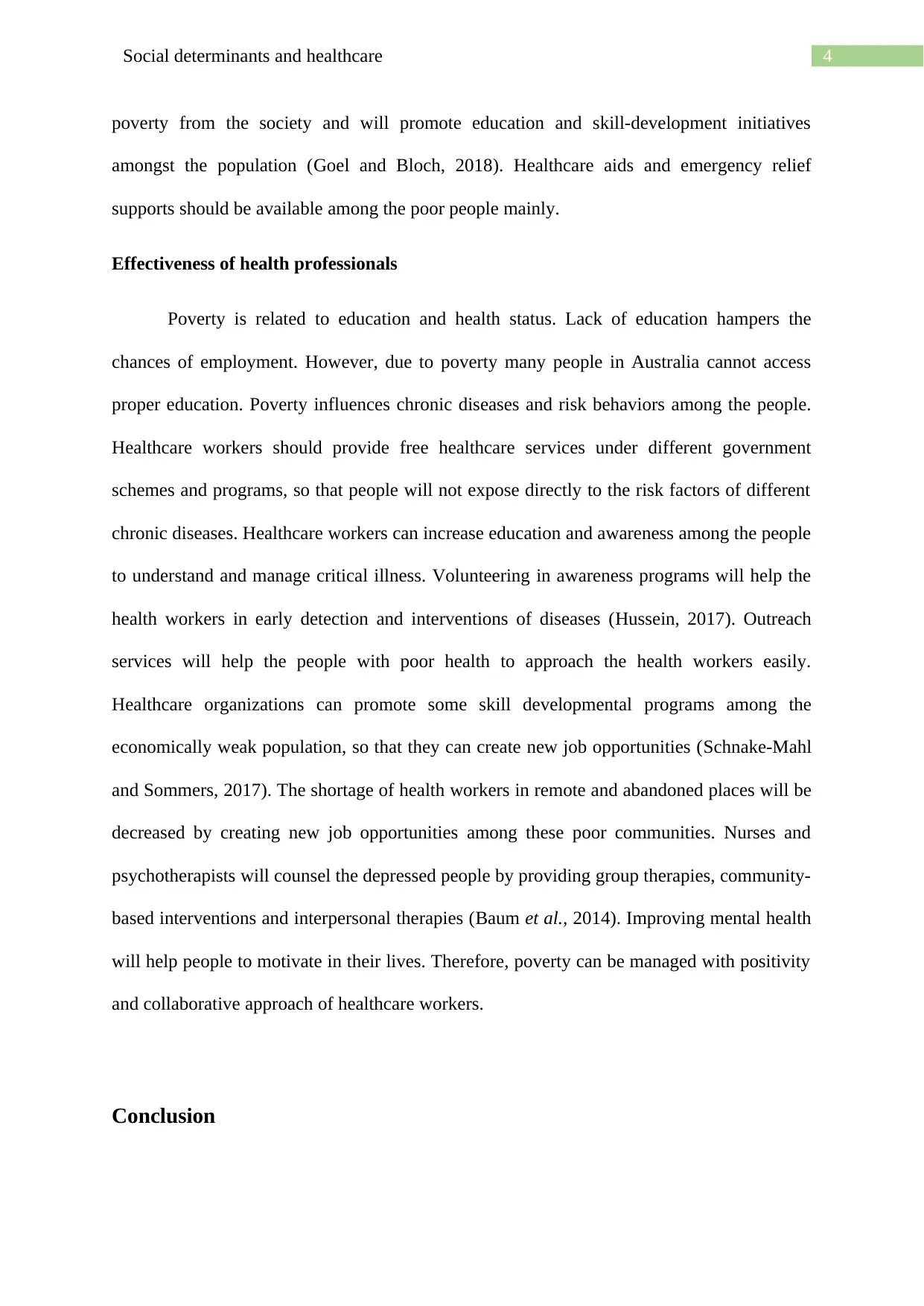
4Social determinants and healthcare
poverty from the society and will promote education and skill-development initiatives
amongst the population (Goel and Bloch, 2018). Healthcare aids and emergency relief
supports should be available among the poor people mainly.
Effectiveness of health professionals
Poverty is related to education and health status. Lack of education hampers the
chances of employment. However, due to poverty many people in Australia cannot access
proper education. Poverty influences chronic diseases and risk behaviors among the people.
Healthcare workers should provide free healthcare services under different government
schemes and programs, so that people will not expose directly to the risk factors of different
chronic diseases. Healthcare workers can increase education and awareness among the people
to understand and manage critical illness. Volunteering in awareness programs will help the
health workers in early detection and interventions of diseases (Hussein, 2017). Outreach
services will help the people with poor health to approach the health workers easily.
Healthcare organizations can promote some skill developmental programs among the
economically weak population, so that they can create new job opportunities (Schnake-Mahl
and Sommers, 2017). The shortage of health workers in remote and abandoned places will be
decreased by creating new job opportunities among these poor communities. Nurses and
psychotherapists will counsel the depressed people by providing group therapies, community-
based interventions and interpersonal therapies (Baum et al., 2014). Improving mental health
will help people to motivate in their lives. Therefore, poverty can be managed with positivity
and collaborative approach of healthcare workers.
Conclusion
poverty from the society and will promote education and skill-development initiatives
amongst the population (Goel and Bloch, 2018). Healthcare aids and emergency relief
supports should be available among the poor people mainly.
Effectiveness of health professionals
Poverty is related to education and health status. Lack of education hampers the
chances of employment. However, due to poverty many people in Australia cannot access
proper education. Poverty influences chronic diseases and risk behaviors among the people.
Healthcare workers should provide free healthcare services under different government
schemes and programs, so that people will not expose directly to the risk factors of different
chronic diseases. Healthcare workers can increase education and awareness among the people
to understand and manage critical illness. Volunteering in awareness programs will help the
health workers in early detection and interventions of diseases (Hussein, 2017). Outreach
services will help the people with poor health to approach the health workers easily.
Healthcare organizations can promote some skill developmental programs among the
economically weak population, so that they can create new job opportunities (Schnake-Mahl
and Sommers, 2017). The shortage of health workers in remote and abandoned places will be
decreased by creating new job opportunities among these poor communities. Nurses and
psychotherapists will counsel the depressed people by providing group therapies, community-
based interventions and interpersonal therapies (Baum et al., 2014). Improving mental health
will help people to motivate in their lives. Therefore, poverty can be managed with positivity
and collaborative approach of healthcare workers.
Conclusion
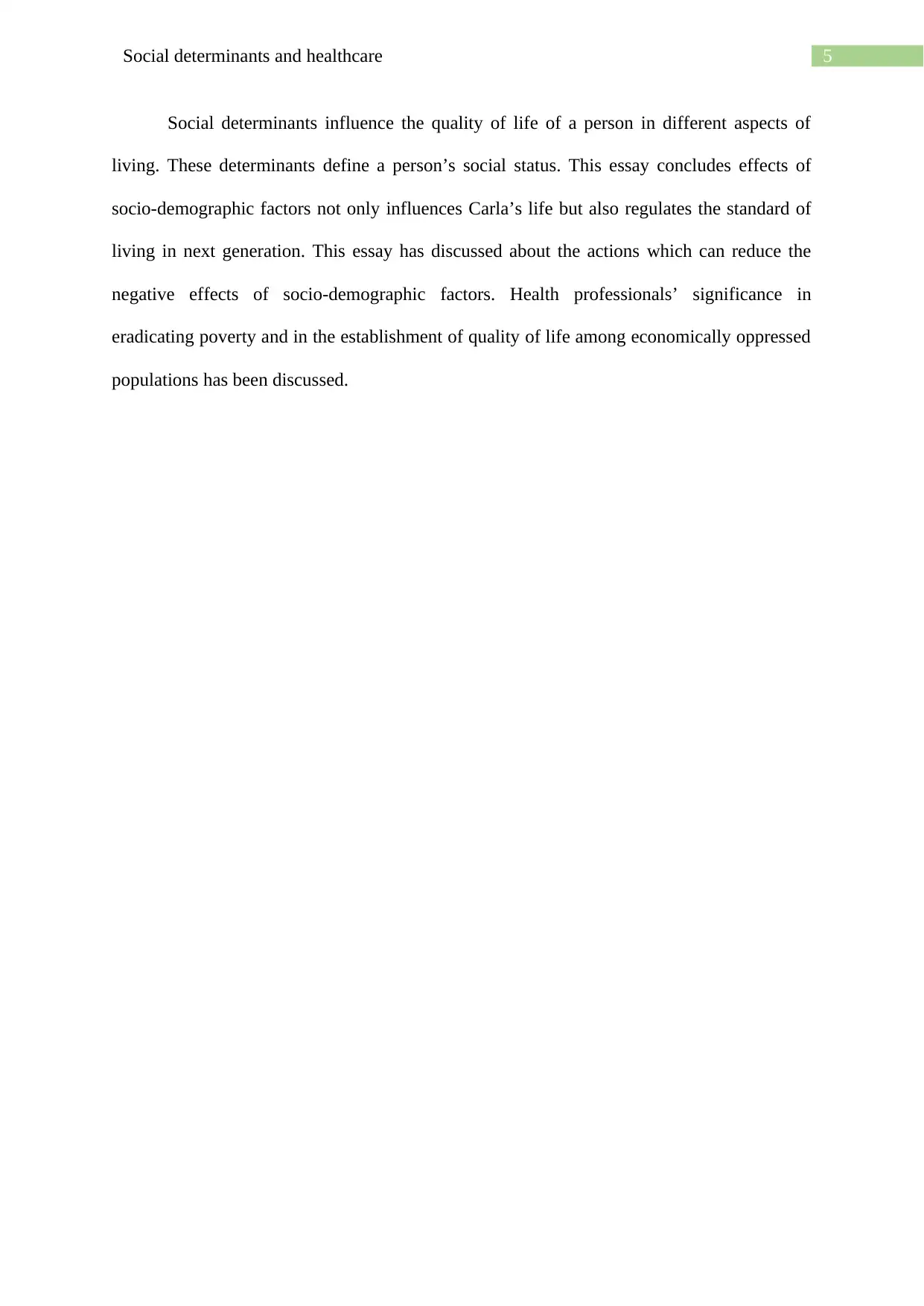
5Social determinants and healthcare
Social determinants influence the quality of life of a person in different aspects of
living. These determinants define a person’s social status. This essay concludes effects of
socio-demographic factors not only influences Carla’s life but also regulates the standard of
living in next generation. This essay has discussed about the actions which can reduce the
negative effects of socio-demographic factors. Health professionals’ significance in
eradicating poverty and in the establishment of quality of life among economically oppressed
populations has been discussed.
Social determinants influence the quality of life of a person in different aspects of
living. These determinants define a person’s social status. This essay concludes effects of
socio-demographic factors not only influences Carla’s life but also regulates the standard of
living in next generation. This essay has discussed about the actions which can reduce the
negative effects of socio-demographic factors. Health professionals’ significance in
eradicating poverty and in the establishment of quality of life among economically oppressed
populations has been discussed.
⊘ This is a preview!⊘
Do you want full access?
Subscribe today to unlock all pages.

Trusted by 1+ million students worldwide
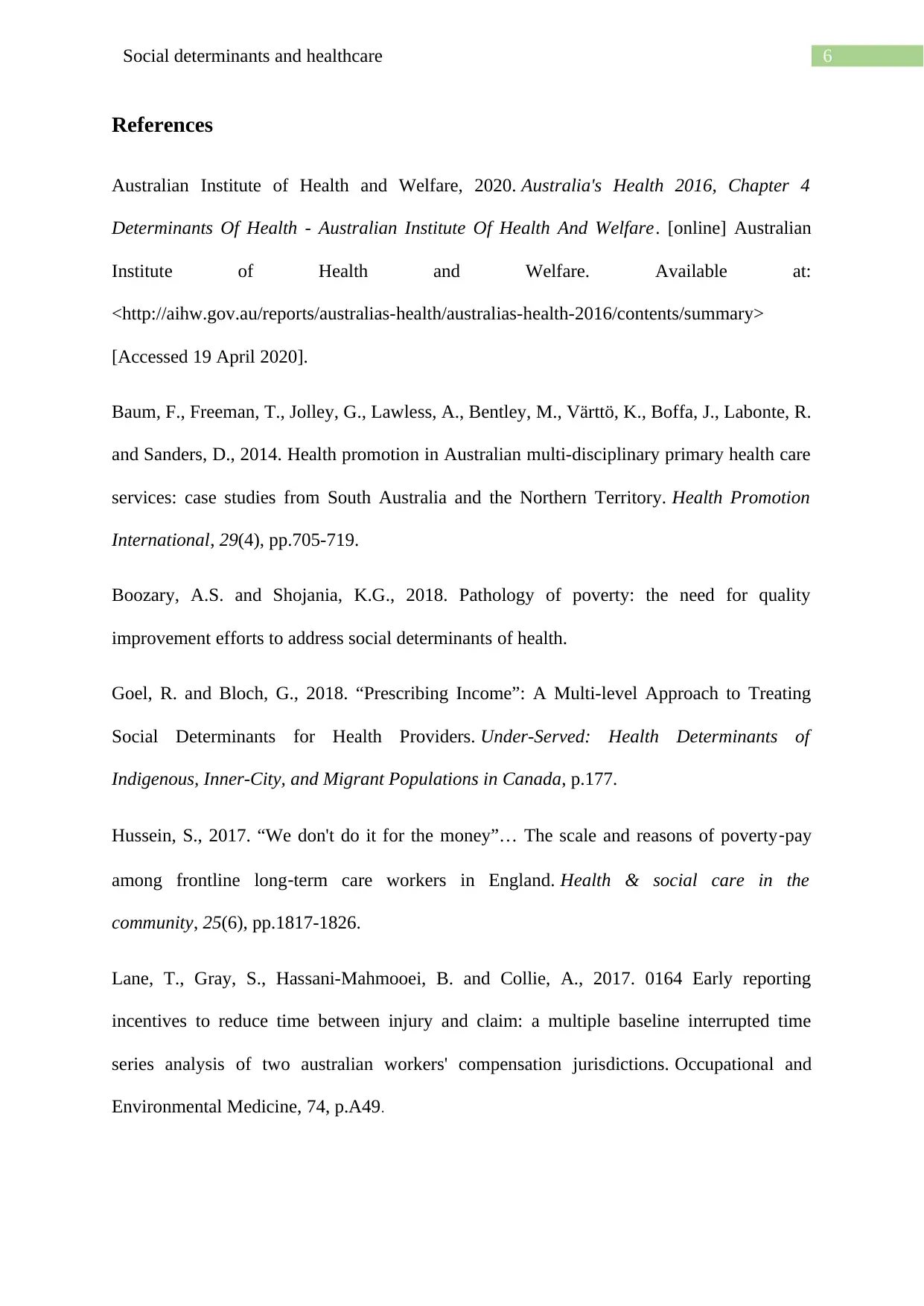
6Social determinants and healthcare
References
Australian Institute of Health and Welfare, 2020. Australia's Health 2016, Chapter 4
Determinants Of Health - Australian Institute Of Health And Welfare. [online] Australian
Institute of Health and Welfare. Available at:
<http://aihw.gov.au/reports/australias-health/australias-health-2016/contents/summary>
[Accessed 19 April 2020].
Baum, F., Freeman, T., Jolley, G., Lawless, A., Bentley, M., Värttö, K., Boffa, J., Labonte, R.
and Sanders, D., 2014. Health promotion in Australian multi-disciplinary primary health care
services: case studies from South Australia and the Northern Territory. Health Promotion
International, 29(4), pp.705-719.
Boozary, A.S. and Shojania, K.G., 2018. Pathology of poverty: the need for quality
improvement efforts to address social determinants of health.
Goel, R. and Bloch, G., 2018. “Prescribing Income”: A Multi-level Approach to Treating
Social Determinants for Health Providers. Under-Served: Health Determinants of
Indigenous, Inner-City, and Migrant Populations in Canada, p.177.
Hussein, S., 2017. “We don't do it for the money”… The scale and reasons of poverty‐pay
among frontline long‐term care workers in England. Health & social care in the
community, 25(6), pp.1817-1826.
Lane, T., Gray, S., Hassani-Mahmooei, B. and Collie, A., 2017. 0164 Early reporting
incentives to reduce time between injury and claim: a multiple baseline interrupted time
series analysis of two australian workers' compensation jurisdictions. Occupational and
Environmental Medicine, 74, p.A49.
References
Australian Institute of Health and Welfare, 2020. Australia's Health 2016, Chapter 4
Determinants Of Health - Australian Institute Of Health And Welfare. [online] Australian
Institute of Health and Welfare. Available at:
<http://aihw.gov.au/reports/australias-health/australias-health-2016/contents/summary>
[Accessed 19 April 2020].
Baum, F., Freeman, T., Jolley, G., Lawless, A., Bentley, M., Värttö, K., Boffa, J., Labonte, R.
and Sanders, D., 2014. Health promotion in Australian multi-disciplinary primary health care
services: case studies from South Australia and the Northern Territory. Health Promotion
International, 29(4), pp.705-719.
Boozary, A.S. and Shojania, K.G., 2018. Pathology of poverty: the need for quality
improvement efforts to address social determinants of health.
Goel, R. and Bloch, G., 2018. “Prescribing Income”: A Multi-level Approach to Treating
Social Determinants for Health Providers. Under-Served: Health Determinants of
Indigenous, Inner-City, and Migrant Populations in Canada, p.177.
Hussein, S., 2017. “We don't do it for the money”… The scale and reasons of poverty‐pay
among frontline long‐term care workers in England. Health & social care in the
community, 25(6), pp.1817-1826.
Lane, T., Gray, S., Hassani-Mahmooei, B. and Collie, A., 2017. 0164 Early reporting
incentives to reduce time between injury and claim: a multiple baseline interrupted time
series analysis of two australian workers' compensation jurisdictions. Occupational and
Environmental Medicine, 74, p.A49.
Paraphrase This Document
Need a fresh take? Get an instant paraphrase of this document with our AI Paraphraser
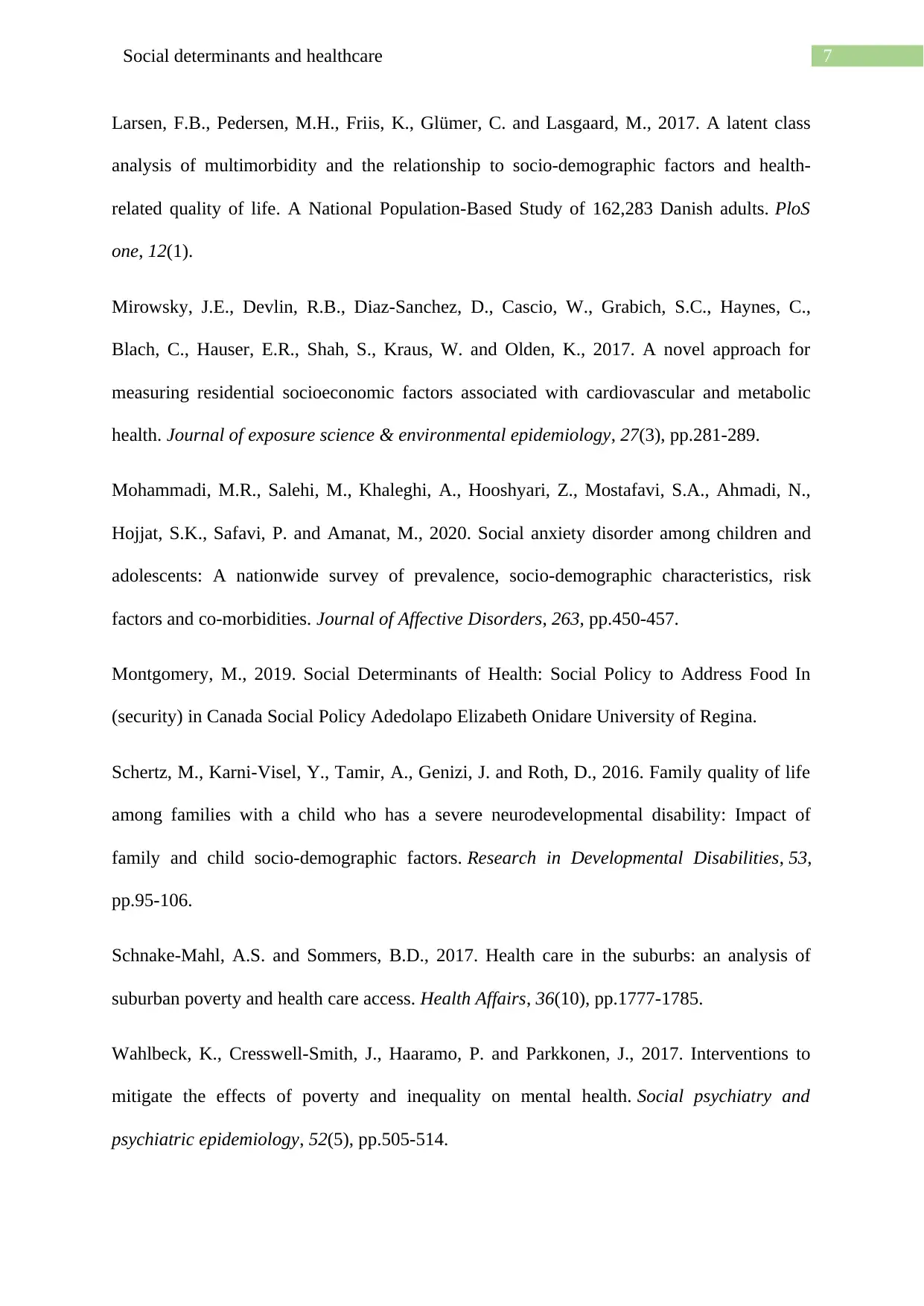
7Social determinants and healthcare
Larsen, F.B., Pedersen, M.H., Friis, K., Glümer, C. and Lasgaard, M., 2017. A latent class
analysis of multimorbidity and the relationship to socio-demographic factors and health-
related quality of life. A National Population-Based Study of 162,283 Danish adults. PloS
one, 12(1).
Mirowsky, J.E., Devlin, R.B., Diaz-Sanchez, D., Cascio, W., Grabich, S.C., Haynes, C.,
Blach, C., Hauser, E.R., Shah, S., Kraus, W. and Olden, K., 2017. A novel approach for
measuring residential socioeconomic factors associated with cardiovascular and metabolic
health. Journal of exposure science & environmental epidemiology, 27(3), pp.281-289.
Mohammadi, M.R., Salehi, M., Khaleghi, A., Hooshyari, Z., Mostafavi, S.A., Ahmadi, N.,
Hojjat, S.K., Safavi, P. and Amanat, M., 2020. Social anxiety disorder among children and
adolescents: A nationwide survey of prevalence, socio-demographic characteristics, risk
factors and co-morbidities. Journal of Affective Disorders, 263, pp.450-457.
Montgomery, M., 2019. Social Determinants of Health: Social Policy to Address Food In
(security) in Canada Social Policy Adedolapo Elizabeth Onidare University of Regina.
Schertz, M., Karni-Visel, Y., Tamir, A., Genizi, J. and Roth, D., 2016. Family quality of life
among families with a child who has a severe neurodevelopmental disability: Impact of
family and child socio-demographic factors. Research in Developmental Disabilities, 53,
pp.95-106.
Schnake-Mahl, A.S. and Sommers, B.D., 2017. Health care in the suburbs: an analysis of
suburban poverty and health care access. Health Affairs, 36(10), pp.1777-1785.
Wahlbeck, K., Cresswell-Smith, J., Haaramo, P. and Parkkonen, J., 2017. Interventions to
mitigate the effects of poverty and inequality on mental health. Social psychiatry and
psychiatric epidemiology, 52(5), pp.505-514.
Larsen, F.B., Pedersen, M.H., Friis, K., Glümer, C. and Lasgaard, M., 2017. A latent class
analysis of multimorbidity and the relationship to socio-demographic factors and health-
related quality of life. A National Population-Based Study of 162,283 Danish adults. PloS
one, 12(1).
Mirowsky, J.E., Devlin, R.B., Diaz-Sanchez, D., Cascio, W., Grabich, S.C., Haynes, C.,
Blach, C., Hauser, E.R., Shah, S., Kraus, W. and Olden, K., 2017. A novel approach for
measuring residential socioeconomic factors associated with cardiovascular and metabolic
health. Journal of exposure science & environmental epidemiology, 27(3), pp.281-289.
Mohammadi, M.R., Salehi, M., Khaleghi, A., Hooshyari, Z., Mostafavi, S.A., Ahmadi, N.,
Hojjat, S.K., Safavi, P. and Amanat, M., 2020. Social anxiety disorder among children and
adolescents: A nationwide survey of prevalence, socio-demographic characteristics, risk
factors and co-morbidities. Journal of Affective Disorders, 263, pp.450-457.
Montgomery, M., 2019. Social Determinants of Health: Social Policy to Address Food In
(security) in Canada Social Policy Adedolapo Elizabeth Onidare University of Regina.
Schertz, M., Karni-Visel, Y., Tamir, A., Genizi, J. and Roth, D., 2016. Family quality of life
among families with a child who has a severe neurodevelopmental disability: Impact of
family and child socio-demographic factors. Research in Developmental Disabilities, 53,
pp.95-106.
Schnake-Mahl, A.S. and Sommers, B.D., 2017. Health care in the suburbs: an analysis of
suburban poverty and health care access. Health Affairs, 36(10), pp.1777-1785.
Wahlbeck, K., Cresswell-Smith, J., Haaramo, P. and Parkkonen, J., 2017. Interventions to
mitigate the effects of poverty and inequality on mental health. Social psychiatry and
psychiatric epidemiology, 52(5), pp.505-514.
1 out of 8
Related Documents
Your All-in-One AI-Powered Toolkit for Academic Success.
+13062052269
info@desklib.com
Available 24*7 on WhatsApp / Email
![[object Object]](/_next/static/media/star-bottom.7253800d.svg)
Unlock your academic potential
Copyright © 2020–2025 A2Z Services. All Rights Reserved. Developed and managed by ZUCOL.





